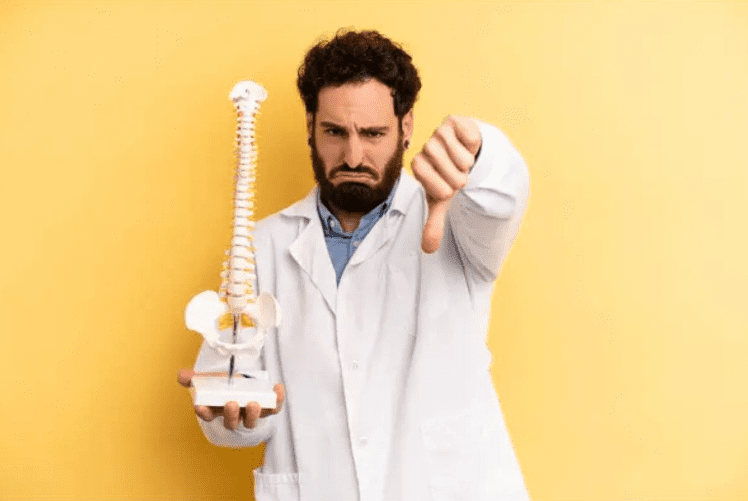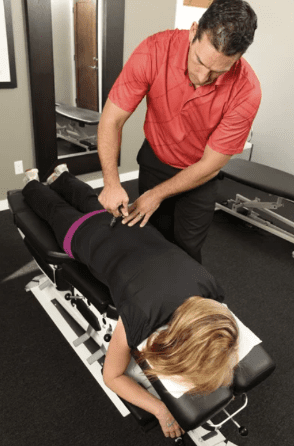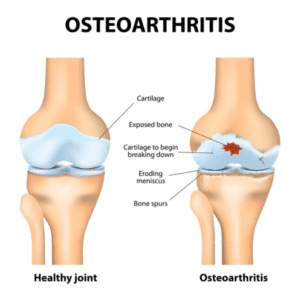A critical discussion from the eyes of an exercise physiologist.
Recently my social media feed has been flooded with videos of the most satisfying cracks and pops delivered by the hands of a chiropractor. The instant relief on the face of the patient is phenomenal and these moans and groans are often accompanied by an account of life-changing pain liberation. Now I don’t know about you, but these videos make my back jealous-and it appears that the feeling is contagious.

In Australia, 300,000 people access these chiropractic miracles every week. At an average cost of $85 per session, this equates to approximately 25.5 million dollars (1,2). Extrapolate this out to a full year, and you will find that 1.3 billion hard-earned Australian dollars are spent on chiropractic services every year.
Whether this be through the public health system or privately funded, this is an extraordinary amount of value placed on this allied health practice. Therefore, you would assume that the patients accessing this service are seeing real, tangible improvements in their health.
So why are my clients reporting the complete opposite?
To understand why this could be the case-and determine if those TikTok’s are just propaganda-I first set out to define what a chiropractor is and what they claim to do.
What is a Chiropractor & What Do they Do?
What I thought would be an easy task, turned out to be quite challenging. Every source appeared to have a different answer, leading me through a rabbit warren of terminology.
The first (and arguably least reliable) definition that popped up on google was from Wikipedia. It defined the chiropractic practice in the following way:
“Chiropractic is a form of alternative medicine concerned with the diagnosis, treatment and prevention of mechanical disorders of the musculoskeletal system, especially of the spine. It has esoteric origins and is based on several pseudoscientific ideas.” (3)
This definition did not fill me with confidence. Terms like alternative, esoteric, and pseudoscientific only add to the cloud of mystery that surrounds the efficacy of this treatment. I continued my search for a reliable and concise definition, which ended at the Australian Chiropractors Association. The ACA states:
“Chiropractic is a drug and surgery-free modality of treatment concerned with the diagnosis, management and prevention of disorders of the musculoskeletal system (spine); this includes the effects of these disorders on the function of the nervous system and general health.” (1,4)


Although broad, the key point from the above definition is that chiropractors provide a conservative treatment for the musculoskeletal system, spine and anything that is caused due to spinal issues. It is interesting then to have heard first-hand accounts of treatment being applied to conditions that have nothing to do with the spine. Claiming that manipulation of the spine can treat asthma, IBS, dysmenorrhoea, and allergies is not only misleading but is completely wrong.
Strong evidence suggests that “chiropractors have very poor efficacy for treating conditions other than the neck and spine” (6). So, if your chiro claims they can treat anything that is not directly related to the spine, I recommend finding another one.
What techniques do chiropractors use? So now that we understand a little bit more about the chiropractic profession and its scope of practice, I could begin to see why some of my patients being treated for knee, ankle, and shoulder problems were not seeing any benefit. But what about the ones there for back and neck pain? Why are they not seeing results?
To attempt to answer this question I began investigating the different approaches that chiropractors have when treating the spine.
Australian Chiropractors were surveyed to discover their most popular treatment methods. The results are as follows (7,8).
· High velocity, low amplitude adjustment/manipulation/mobilization – 82.2%.
· Extremity manipulation – 58.8%.
· Drop-piece techniques/Thomson – 53.7%.
· Instrument adjusting – 52.3%.
All these techniques involve your chiropractor manually placing pressure through the affected vertebral segment, whether with their hands or with equipment. This can be summarised as spinal manipulation.


The theory behind spinal manipulation is twofold. The mechanistic (biomechanical) approach suggests that spinal manipulation therapy (SMT) acts to reduce internal mechanical stresses and can often be referred to as realignment. This attempts to create a greater range of motion and improve function. The neurophysiological approach suggests that SMT affects the sensory system, meaning the neural network that controls movement and relays pain responses is altered (9).
According to chiropractic experts, to receive these benefits each adjustment is delivered at a precise angle, depth, direction, and speed, which is determined through “years of practice, experience, education, and diagnostic expertise”.
Sounds all well and good, but the first thing that springs to mind when hearing this, is how on earth do you practice delivering a high-velocity adjustment that has to be precisely the right angle, depth, and direction? With everybody being different, even if X-rays are conducted, there is too much anatomical variation to guarantee a safe, precise, or effective adjustment. And let me ask you this, has your chiro ever sent you for X-rays post-treatment to check if they have even re-aligned anything at all?
Sounds risky to me, but it appears many are willing to take the risk to get the reward. There is safety in numbers and trust in tradition. Being around for so long, it must be an effective treatment. Right? Let’s explore what the evidence tells us about the effectiveness of spinal manipulation both with and without additional instruments.
Is spinal manipulation effective?
A fantastic article published in 2019 provided a clear and concise review of the current database regarding the benefits of spinal manipulative therapy (SMT) (9). The systematic review compared SMT against three categories, which each provided an interesting insight into how SMT can be used to provide real tangible results in pain reduction and improvement of function.
Firstly, let’s look at the comparison between SMT and non-recommended therapies, which means therapies that have already been proven not to improve back pain and functionality. This includes things like soft tissue massage, electrotherapies, and even no treatment at all.
Amazingly, in terms of pain reduction, chiropractic therapy did not perform any better than these ineffective treatments at 1 month, 6 months or 12 months of consistent appointments. Even compared to no treatment at all! However, it has been shown to improve function when compared to non-recommended therapies across all time frames. Interesting results.
The paper went on to compare SMT to “sham” SMT, which is their way of controlling for the all-important element of placebo. Sham SMT consisted of setting up a fake chiropractic clinic where individuals would conduct fake treatments on patients. This involved hand contact through active or passive range of motion. These techniques simulated SMT but were designed not to deliver a therapeutic effect by using light touch for diminished therapeutic force or even improper patient positioning or purposely misdirected movements.
Once again, the real SMT had no statistically better result in pain reduction when compared to placebo. And astonishingly, did not result in any better improvement in function than sham treatment after the one-month time frame. This means that there was no evidence of those “precise” corrections outlined in Chiropractic techniques being any better at reducing pain and long-term function improvement than moving the body willy-nilly! An amazing stat, and one that shows that even having a more experienced Chiropractor will not give you better results.
SMT was then compared against other clinically recommended therapies, meaning, ones that are proven to work. These consist of things like exercise and drug treatments, including anti-inflammatory drugs and pain relievers. SMT was proven to be worse at reducing pain than these other strategies in the one-month and 12-month categories. In terms of function, SMT was only more effective at improving function in the first month, proving better than other therapies. However, on a longer time frame, it had no statistically better results. Therefore, we can assume that SMT is a subpar long-term treatment when compared to other modalities on offer.
This is reflected in my client’s experiences. You often hear that the day after chiropractic treatment is fantastic, with no pain and being mobile again. But on a larger scale, they are not seeing long-term, tangible improvements and are forced to continue returning for session after session. No doubt a successful business model.
Does this mean that Chiropractors have no place in the allied health world?
The most recent summary of guidelines appears to cement my understanding, suggesting that SMT should be considered a second-line or adjuvant treatment option, after exercise or cognitive behavioural therapy (6,9). When used in conjunction with other therapy, chiropractic does increase the effectiveness of treatment and therefore cannot be entirely discredited.
It appears that the profession is aware of this, as more chiropractors are turning towards prescribing exercise as well as creating behavioural and lifestyle changes; perhaps adopting the latest research and leaving old, ineffective treatments in the past.
Without the efficacy of spinal manipulation and with physiotherapists and exercise physiologists already mastering exercise prescription and lifestyle modification, does this leave a place for the chiropractic profession?
Based on my experience and the research undertaken for this piece, there is still a place for chiropractors. The short-term benefits of increasing mobility and function are very useful in complex cases of chronic back pain, but only as a tool to get the individual back into movement again. As we have proved in this discussion, the long-term benefits of spinal manipulation do not stack up against other proven treatments. Therefore, individuals should progress swiftly from chiropractic into exercise therapy, to rebuild strength and regain the ability to live independently, without the need for a back crack every two weeks!
References
1. Australian Chiropractors Assosciation (2023). About Chiropractic. The Australian Chiropractors Association (ACA),. https://www.chiro.org.au/about-chiropractic/chiropractic-and-you
2. How much does a chiropractic cost in Australia? (2023) Australian Tips. Available at: https://tipsaustralia.com/chiropractic-cost-in-australia/
3. Chiropractic (2023) Wikipedia. Available at: https://en.wikipedia.org/wiki/Chiropractic (Accessed: 07 December 2023).
4. About chiropractic (2020) ACA. Available at: https://www.chiro.org.au/aboutchiropractic/ (Accessed: 21 February 2024).
5. Ernst, E. (2008). Chiropractic: A critical evaluation. National Library of Medicine. https://doi.org/10.1016/j.jpainsymman.2007.07.004
6. Simpson, K. (2022). Historical Vignettes: Important historical events that have shaped modern chiropractic practice in Australia. Chiropractic Journal of Australia, 49(1). https://doi.org/https://www.cjaonline.com.au/index.php/cja/article/view/305/140
7. Clijsters, M., Fronzoni, F. and Jenkins, H. (2014) ‘Chiropractic treatment approaches for spinal musculoskeletal conditions: A cross-sectional survey’, Chiropractic & Manual Therapies, 22(1). doi:10.1186/s12998-014-0033-8.
8. McGlynn, P. et al. (2022) ‘CHIROPRACTIC SCOPE OF PRACTICE AND CLINICAL COMPETENCIES IN AUSTRALIA Part 1 – Scope of Practice and advanced titling’, Chiropractic Journal of Australia, 49(1). doi:https://www.cjaonline.com.au/index.php/cja/article/view/288.
9. Rubinstein, S.M. et al. (2019) ‘Benefits and harms of spinal manipulative therapy for the treatment of chronic low back pain: Systematic review and meta-analysis of Randomised Controlled Trials’, BMJ, p. l689. doi:10.1136/bmj.l689.





















